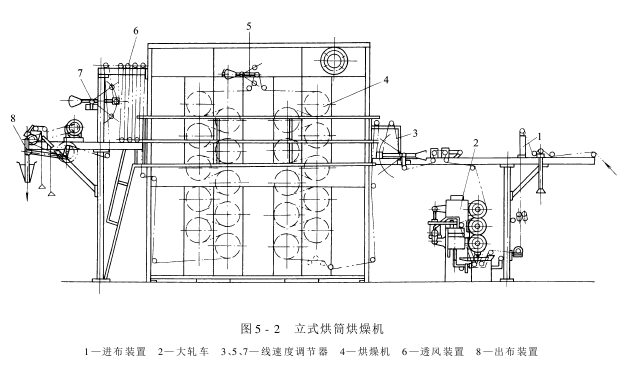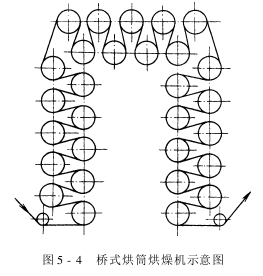Cylinder dryer – type
The main advantage of the drum dryer is its relatively high drying efficiency. This is because the heat carrier of the drum dryer is metal and the moisture carrier is air, so it does not lose too much heat when discharging moisture. The machine structure is relatively compact, and it occupies a small area. The heat lost is few. Therefore, cylinder dryers are widely used in dyeing and finishing.
Drying cylinder dryers can be divided into three types: standing type, horizontal type and bridge type according to the arrangement of the drying cylinders, as shown in Figure 5-2 to Figure 5-4 respectively.



1. Stationary drum dryer
This is the most widely used drying machine in dyeing and finishing. Dryer. There are several types such as single column, double column, three column and four column, which can be selected according to the actual process requirements. Each pair of standing columns is equipped with 8, 10 or 12 drying cylinders. For this kind of equipment for drying polyester-cotton blended chemical fiber fabrics and other fabrics, the last three drying cylinders should be changed to cooling rollers. Otherwise, 2 to 3 cooling rollers should be added at the end to reduce the temperature of the fabric and prevent permanent damage to the fabric. Sexual wrinkles.
2. Horizontal drum drying machine
The hot and humid air generated when drying fabrics is simply discharged and dispersed, without affecting the drying capacity of other drums. It is more convenient to install, inspect, thread and operate. However, because the equipment occupies a large area, it is rarely used.
3. Bridge drum dryer
It is a hybrid dryer composed of stationary and horizontal dryers. Its biggest feature is its compact structure. However, it is more difficult to remove hot and humid air, so the drying capacity is lower than the other two types, and the structure is complex, making installation, maintenance and operation inconvenient. Therefore, it is rarely used in dyeing and finishing.
AAAFNJKIYO9P







